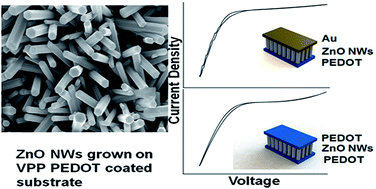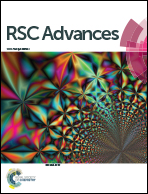New junction materials by the direct growth of ZnO NWs on organic semiconductors†
Abstract
Ordered hetero-junctions using one dimensional inorganic nanostructures have been widely studied to develop devices such as high efficiency photovoltaic devices, light emitting diodes, catalysts, supercapacitors, lithium ion batteries and nanogenerators. High quality Schottky contacts can be obtained by the spin coating of conducting polymer dispersions/solutions onto inorganic nanostructures; however, the interaction of polar surfaces of the nanostructures with chemically active materials in the spin coating solution makes the junctions less reliable. In the present work, we show that high quality junctions can be fabricated by either directly growing the nanostructures onto the vapour phase polymerised (VPP) poly(3,4-ethylenedioxythiophene) (PEDOT) substrates or sandwiching VPP polymerised substrates, thereby avoiding any unwanted interactions with the acidic additives from the polymer solution at the organic–inorganic interfaces. The I–V measurements proved that the direct growth of ZnO NWs on PEDOT coated substrates creates an ohmic contact, whereas the PEDOT layer on top surface produces a Schottky contact due to the dipole moment with the polar ends.



 Please wait while we load your content...
Please wait while we load your content...